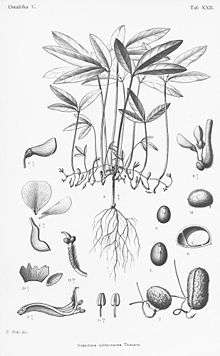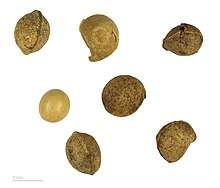Vigna subterranea
Vigna subterranea (also known by its common names: Bambara nut, Bambara-bean,[2] Congo goober,[2] earth pea,[3] ground-bean,[2] or hog-peanut[2]) is a member of the family Fabaceae. The plant originated in West Africa (the Bambara people are found in southern Mali, Guinea, Burkina Faso and Senegal). Vigna subterranea ripens its pods underground, much like the peanut (also called a groundnut). They can be eaten fresh or boiled after drying.
| Vigna subterranea | |
|---|---|
 | |
| Scientific classification | |
| Kingdom: | |
| (unranked): | |
| (unranked): | |
| (unranked): | |
| Order: | |
| Family: | |
| Genus: | |
| Species: | V. subterranea |
| Binomial name | |
| Vigna subterranea (L.) Verdc. | |
| Synonyms[1] | |
| |
Agronomic aspects

Origin and cultivation
The origin of the Bambara groundnut is West Africa[4] and the region of cultivation is Sub-Saharan Africa's warm tropics.[5] Bambara nut grows well any where groundnut (peanut) grows and so is vastly present from Kwara state and throughout the northern parts of Nigeria.
Importance
Bambara groundnut represents the third most important grain legume in semi-arid Africa.[6] “It is resistant to high temperature and is suitable for marginal soils where other leguminous crops cannot be grown”,[7] thereby considered as a low-impact crop.[8]
Bambara groundnut has nutritive value with 65% carbohydrate and 18% protein content. It is considered to be a neglected and underutilized food source in Benin.[9]
Uses
Culinary use
The seeds are used for food and beverage because of their high protein content[10] and for digestive system applications.[10] The entire plant is known for soil improvement[10] because of nitrogen fixation. In West Africa, the nuts are eaten as a snack, roasted and salted, processed into cake, or as a meal, boiled similar to other beans.
In South Eastern Nigeria, particularly in Enugu, the dried bambara beans are ground into a fine powder, then mixed with palm oil, water and pumpkin leaves and then poured into banana leaf wraps or 1 litre cellophane bags before being boiled into a kind of cakey pudding to make "okpa", a common breakfast food in Enugu, Nsukka and Ngwo Nigeria. In Niger State and upper Kwara state the Nupes and Yorubas have a delicacy called Sagidi, a meal sold in every Friday and Saturday market. Just like Groundnut Cake (Kulikuli cake), the Bambara nut is processed to Kangu cake starting from Kwara through northern Nigeria, Chad and Niger. During the rainy season in many parts of central Nigeria like Jos, the fresh bambara beans are cooked with their shells still on them. The beans are then eaten as a snack just like boiled groundnuts.
Soil requirements
Optimal soils for Bambara groundnut production are sandy soils to prevent waterlogging. Optimal soil depth is between 50 and 100 cm,[10] with a light soil texture.[10] soil fertility should be low[10] and soil pH is best suited between 5 and 6.5[10] and should not be lower than 4.3[10] or higher than 7.[10]
Climate requirements
The production is best suited between a latitude of 20° - 30°,[10] i.e. the tropical wet and dry (Aw)[10] and the subtropical dry summer (Cs)[10] climate zones. Optimal temperature is between 19 °C[10] and 30 °C.[10] Temperatures below 16 °C[10] and above 38 °C[10] are not suited for the production of bambara groundnut. The bambara groundnut is very drought resistant.[5] The minimal annual rainfall requirement is about 300 mm[10] and optimal annual rainfall is between 750 mm[10] and 1400 mm[10] and should not exceed 3000 mm.[10]
Cropping system
The cropping system is semi-permanent and the Bambara groundnut can be cultivated as single crop or as intercrop.[10] Best suited intercrops are sorghum, millet, maize, peanut, yams and cassava.[10]
Bambara groundnut is mainly cultivated as intercrop, however the planting density varies between 6 and 29 plants per square meter.[11] For woodland savannas of Côte d'Ivoire the highest yield is attainable with a plant density of 25[12] plants per square meter.
Production
World production of Vigna subterranea increased from 29,800 tonnes in 2015.[13] in 1972 to 79,155 tonnes[13]
| Production Year 2013 (Source FAOSTAT)[13] | Area Harvested (Ha) | Yield (kg/ha) | Production (tonnes) |
|---|---|---|---|
| 120,000 | 9,498 | 113,981 | |
| 68,000 | 4,412 | 30,000 | |
| 55,000 | 8,909 | 49,000 | |
| 43,392 | 8,444 | 36,639 | |
| 4,828 | 750 | 14,000 | |
| World | 315,392 | 7,724 | 243,620 |
Physiology
Growth
The growth cycle is between (min-max) 90–170 days[10] and under optimal conditions the cycle is about 120–150 days[5] to pod maturity. Flowers appear 40–60 days[5] after planting. 30 days[5] after pollination the pod reaches maturity and during another 55 days[5] the seeds fully develop. Every 30 days they are produced again.
Generative reproduction
Generative reproduction is for the Bambara groundnut autogamous[5] (self-fertilization) and cleistogamous[5] (self-pollinating).
References
| Wikimedia Commons has media related to Vigna subterranea. |
- "The Plant List: A Working List of All Plant Species".
- "Vigna subterranea". Germplasm Resources Information Network (GRIN). Agricultural Research Service (ARS), United States Department of Agriculture (USDA). Retrieved 15 December 2017.
- "Definition And Classification Of Commodities (Draft): 4. Pulses And Derived Products". Food and Agriculture Organization. 1994. Retrieved 21 June 2013.
- Hepper, FN (1963). "Plants of the 1957-58 West Africa Expedition II: The bambara groundnut (Voandzeia subterranea) and Kersting's groundnut (Kerstingiella geocarpa) wild in West Africa". Kew Bulletin. 16 (3): 395–407. doi:10.2307/4114681. JSTOR 4114681.
- Nichterlein, Karin. "Vigna subterranea". Ecoport. Retrieved 16 March 2011.
- Ocran, V. K (1998). Seed Management Manual for Ghana. Accra Ghana: MOFA.
- Yamaguchi, M (1983). World Vegetables. New York: Van Nostrand Reinhold.
- Baryeh, E.A. (2001). "Physical properties of bambara groundnuts". Journal of Food Engineering. 47 (4): 321–326. doi:10.1016/s0260-8774(00)00136-9.
- Dansi, A.; R. Vodouhe; P. Azokpota; et al. (19 April 2012). "Diversity of the Neglected and Underutilized Crop Species of Importance in Benin". The Scientific World Journal. 2012: 932947. doi:10.1100/2012/932947. PMC 3349165. PMID 22593712.
- "Data sheet Vigna subterranea". Ecocrop. FAO. Retrieved 16 March 2011.
- Rassel, A (1960). "Voandzou, Voandzeia subterranea Thouars, and its cultivation in Kwango". Bull. Agric. Congo Belge. 51: 1–26. Retrieved 16 March 2011.
- Kouassi, N’. J; I. A. Zoro Bi (2010). "Effect Of Sowing Density And Seedbed Type On Yield And Yield Components In Bambara Groundnut (Vigna subterranea) In Woodland Savannas Of Cote D'ivoire". Experimental Agriculture. 46: 99–110. doi:10.1017/S0014479709990494.
- "FAOSTAT". FAO. Archived from the original on September 6, 2015. Retrieved 2 February 2015.
External links
- Bambara Groundnut -- Voandzeia subterranea (L.) Thouars
- Bambara Groundnut ... a Link from the Past and Resource for the Future
- "Vigna subterranea". Integrated Taxonomic Information System.